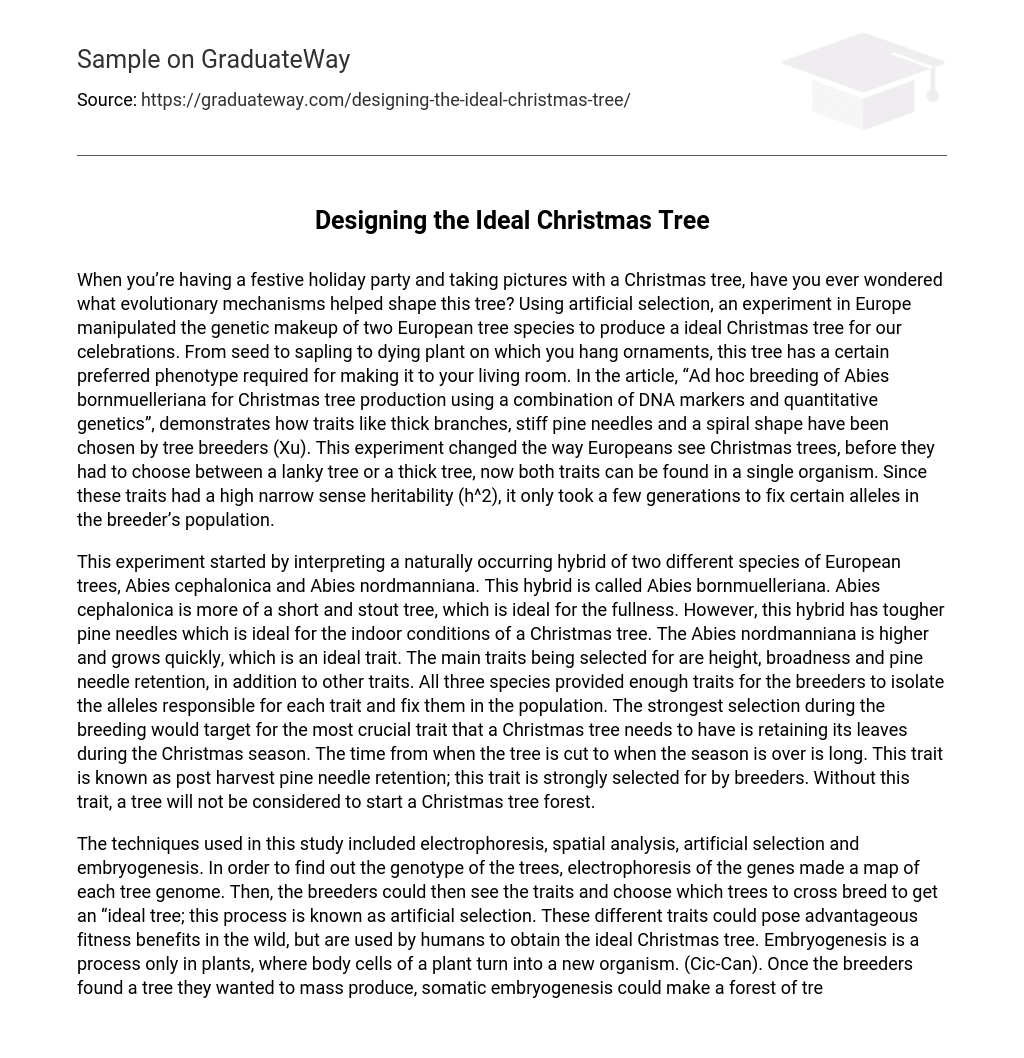When you’re having a festive holiday party and taking pictures with a Christmas tree, have you ever wondered what evolutionary mechanisms helped shape this tree? Using artificial selection, an experiment in Europe manipulated the genetic makeup of two European tree species to produce a ideal Christmas tree for our celebrations. From seed to sapling to dying plant on which you hang ornaments, this tree has a certain preferred phenotype required for making it to your living room. In the article, “Ad hoc breeding of Abies bornmuelleriana for Christmas tree production using a combination of DNA markers and quantitative genetics”, demonstrates how traits like thick branches, stiff pine needles and a spiral shape have been chosen by tree breeders (Xu). This experiment changed the way Europeans see Christmas trees, before they had to choose between a lanky tree or a thick tree, now both traits can be found in a single organism. Since these traits had a high narrow sense heritability (h^2), it only took a few generations to fix certain alleles in the breeder’s population.
This experiment started by interpreting a naturally occurring hybrid of two different species of European trees, Abies cephalonica and Abies nordmanniana. This hybrid is called Abies bornmuelleriana. Abies cephalonica is more of a short and stout tree, which is ideal for the fullness. However, this hybrid has tougher pine needles which is ideal for the indoor conditions of a Christmas tree. The Abies nordmanniana is higher and grows quickly, which is an ideal trait. The main traits being selected for are height, broadness and pine needle retention, in addition to other traits. All three species provided enough traits for the breeders to isolate the alleles responsible for each trait and fix them in the population. The strongest selection during the breeding would target for the most crucial trait that a Christmas tree needs to have is retaining its leaves during the Christmas season. The time from when the tree is cut to when the season is over is long. This trait is known as post harvest pine needle retention; this trait is strongly selected for by breeders. Without this trait, a tree will not be considered to start a Christmas tree forest.
The techniques used in this study included electrophoresis, spatial analysis, artificial selection and embryogenesis. In order to find out the genotype of the trees, electrophoresis of the genes made a map of each tree genome. Then, the breeders could then see the traits and choose which trees to cross breed to get an “ideal tree; this process is known as artificial selection. These different traits could pose advantageous fitness benefits in the wild, but are used by humans to obtain the ideal Christmas tree. Embryogenesis is a process only in plants, where body cells of a plant turn into a new organism. (Cic-Can). Once the breeders found a tree they wanted to mass produce, somatic embryogenesis could make a forest of trees out of some cells of the parent tree. This is an example of asexual reproduction, all of the new trees will have the “ideal” traits of the parent tree. Asexual reproduction is advantageous in this scenario because a lot of progeny can arise in a short amount of time. However, if a parasite were to infect this “ideal” phenotype, then the whole supply of Christmas trees would be lost since there was no variation of traits.
In order for artificial selection to take place, we need to know that these traits are genetic instead of an adaptation to environmental conditions. Artificial selection is made possible by violating the non-random mating assumption of the Hardy-Weinberg principle. The Hardy-Weinberg principle assumes that every individual has equal chance of mating with another. However, in artificial selection, only trees with selected alleles get to reproduce. This would tip the allele frequency fulcrum and make an allele frequency get fixed.
In order for these traits to be used in artificial selection, they must be heritable. We know that these traits are heritable because they have a narrow sense heritability coefficient (h^2). Some traits are more heritable than others, which we can assess by interpreting the heritability coefficient (h^2). If a trait has high heritability, then the allele frequency will be higher in the next generation, and the trees will have a phenotype closer to the ideal phenotype. The size of the tree has a high h^2 value, (.34 for height and .28 for width). Other traits like the color, needle placement and branch size were less than .20. Higher narrow sense heritability means the saplings will display a phenotype that resembles the parent trees, which will make the artificial selection process go faster. Therefore, it would take more generations of breeding for the traits with lower heritability to be fixed in the population.
This experiment took 20 years to see the changes in allele frequencies they wanted, but artificial selection made this possible in a diminutive number of generations. The Christmas tree was modified with modern tools like electrophoresis, spatial analysis and somatic embryogenesis combined with the age old interference of humans in evolution, aka artificial selection. The new hybrid trees with an ideal phenotype were used to make forests of these trees to be sold to families during the holiday season. In order for the breeders to achieve this phenotype, the traits heritability had to be high enough to see results in a few generations. This experiment resulted in a hybrid that makes holiday traditions convenient. Thanks to evolution seen in a small number of generations, humans see a Christmas tree that fulfills every expectation.
Work Cited
- Xu, J., Neilson, U., & Hansen, O. (2018). Tree Genetics and Genomes introduces Continuous Article Publishing. Tree Genetics & Genomes, 14 (5), 64th article.
- Cic-Can, G. I., Galaz-Alcaros, R. M., et al. (2015). Somatic Embryogenesis: Identified factors that lead to Embryogenic Repression. A Case of Species of the Same Genus. PloS one, 10 (6), 30126414. Doi: 10.1371/journal.pone.126414





